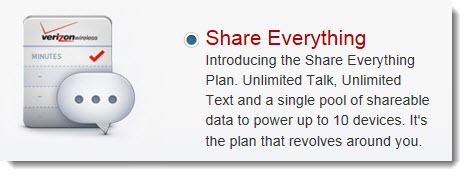Verizon and AT&T are both offering new share plans that allow all of the family devices to share unlimited calls, unlimited texting, and a pool of data that can be used by up to 10 devices – smartphones, tablets, and PCs. If you already have a number of devices with individual data plans, one of the share plans might save you some money, and it makes it tempting to get more broadband devices in the future.
(Verizon’s plan is available now. AT&T’s plan will be available on August 23.)
For the last few years the cost of a data plan has been an annoying consideration with each new device. Each iPad and each iPhone or Android phone requires another $20-$50/month for a data plan to run it. Turning on the mobile hotspot capability in a phone or getting a mobile hotspot from the carriers adds another $20 or more to the bill. I got an iPad with a Verizon chip but I never activated it as a way to keep the bill down. On the other hand, I carry around a Verizon mobile hotspot for emergencies and had been paying $50/month even though I rarely use it.
The share plan simplifies your monthly fee and removes some of the uncertainty about pools of minutes and limitations on text messages. We used to overbuy minutes to avoid unexpected charges. Now they’ve shifted the uncertainty over to the decision about how much data we will need for all of our devices, hoping that we will overbuy a data plan.
You have to choose the amount of data that your devices will share each month, a calculation that is likely to be based on irrational guessing, fear, and the I Ching. (Tip: nothing uses much data except watching video. Those Netflix TV shows chew through data fast; your email doesn’t.) Verizon posts plans up to 10Gb/month on its web site, and it was revealed today that there are more data tiers above those, extending all the way up to 20Gb/month. It’s guesswork. Your best bet is to pick an arbitrary number and then check the web site regularly for a few months to see what you’re really using.
There are two things that are opened up by a share plan.
The first is that you can use an iPhone or Android phone as a mobile hotspot without any extra charge, creating a small wireless network that provides Internet access for your computer. The phones have that capability built in; expect the usual headaches trying to figure it out the first time.
The second is that you can feel much more free about buying mobile broadband devices. There are two places where you might make a different decision with a share plan:
- If you’re considering an iPad or other tablet, get one that includes the Verizon or AT&T cellular option. A share plan lowers the price of turning on that data connection.
- A Verizon or AT&T mobile broadband connection can be built into some business notebooks. That fell out of fashion for a while due to the high cost of the data plan and the difficulty of transferring the plan to a different device later. The share plan relieves both of those worries. The mobile broadband option should be more appealing on notebooks as share plans become more widespread.
Do the calculation about switching to a share plan just in case; you might find that it’s worth it to give up that grandfathered “unlimited” plan (which probably isn’t really unlimited, since the carriers continually change the rules about those “unlimited” plans). I saved a bit of money each month, plus I turned on my iPad’s Verizon connection, and turned on tethering on all our phones. See if it works out in your favor!

